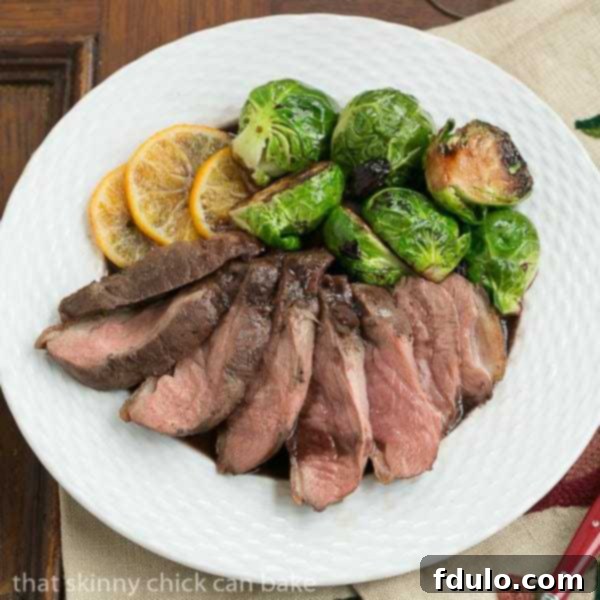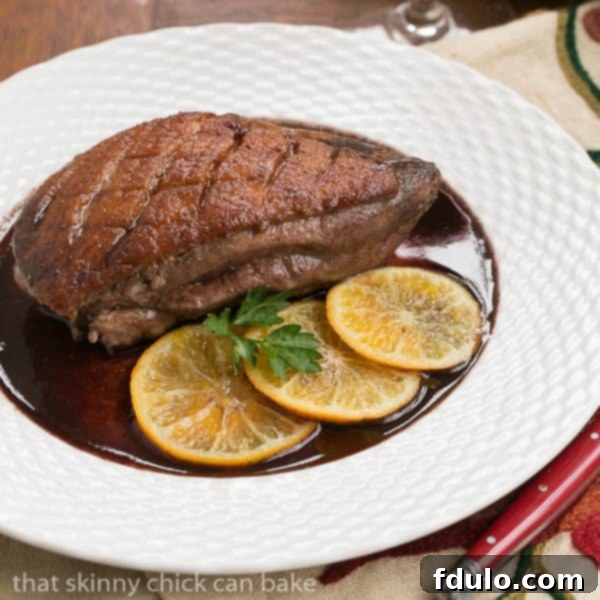Embark on a culinary journey this holiday season with this exquisite recipe for Pan-Seared Duck Breasts with Clementine Red Wine Sauce. This gourmet dish, featuring perfectly rendered crispy duck skin, tender meat, and a vibrant sauce, promises a restaurant-worthy experience in the comfort of your own home. The unique combination of candied citrus notes and a rich, aromatic red wine reduction elevates this classic to an unforgettable masterpiece, ideal for festive gatherings or a special romantic dinner.
While many duck recipes lean on the traditional orange sauce, this innovative Duck Breast Recipe introduces the bright, delicate sweetness of clementines, creating a truly exceptional and less common flavor pairing. The subtle tartness and fragrant zest of clementines offer a refreshing counterpoint to the savory duck, making each bite a delightful surprise.

Why You Must Make These Gourmet Duck Breasts
Cooking duck breast at home might seem intimidating, but with the right guidance, it’s remarkably straightforward. This recipe, inspired by the legendary Dorie Greenspan, is a testament to her philosophy of making sophisticated French cuisine accessible to home cooks. Here’s why this recipe deserves a spot on your culinary agenda:
- Authored by a Culinary Icon: Dorie Greenspan is renowned for crafting foolproof recipes that yield spectacular results. Her precise methods ensure that even novice cooks can achieve perfection, making this dish a reliable choice for any occasion.
- A True Crowd-Pleaser: For those who appreciate the rich flavor and succulent texture of duck, this recipe is a dream come true. Mastering duck at home allows you to enjoy a luxurious meal without the restaurant price tag. Your family and guests will be thoroughly impressed!
- Simplicity Meets Elegance: The core of this recipe focuses on fundamental techniques: scoring the skin, rendering the fat, and achieving a beautifully crisp skin while keeping the meat tender and cooked to a perfect rare or medium-rare. These steps, while crucial, are surprisingly simple to execute.
- Unique Flavor Profile: Move beyond the ordinary with a sauce that marries the richness of red wine and balsamic vinegar with the bright, citrusy notes of clementines. This unique twist elevates the dish, offering a more complex and refined taste experience compared to traditional orange sauces.
- Perfect for Special Occasions: Whether it’s a holiday feast, an anniversary dinner, or simply a desire to treat yourself, this pan-seared duck breast is designed to impress. Its elegant presentation and rich flavors make it an ideal centerpiece for any celebratory meal.
Essential Tips for Perfect Pan-Seared Duck Breasts
Achieving restaurant-quality duck breast at home is all about attention to a few key details. Follow these expert tips to ensure your dish is nothing short of magnificent:
- Citrus Choice and Candying: The original recipe calls for kumquats, which are candied to create a sweet, tangy garnish and a flavorful syrup for the sauce. If kumquats are unavailable, clementines, tangerines, or even small oranges make excellent substitutes. When candying, slice the citrus thinly and simmer gently in a sugar syrup until translucent and tender. This step adds a beautiful visual appeal and a burst of concentrated citrus flavor.
- Precise Skin Scoring: This is a critical step for perfect duck breast. Using a very sharp knife, carefully score the duck skin in a diamond or crosshatch pattern. Ensure you cut through the fat layer but avoid piercing the meat. Scoring allows the fat to render efficiently, resulting in irresistibly crispy skin and preventing the meat from becoming greasy.
- Choose the Right Cookware: Dorie Greenspan wisely recommends using a Dutch oven or a deep, heavy-bottomed skillet for searing duck breasts. This type of cookware helps contain any fat splatter, making for a cleaner cooking experience while ensuring even heat distribution for a consistent sear.
- Achieving Crispy Skin: The goal is a golden-brown, wonderfully crisp skin. Cook the duck skin-side down over medium-high heat until the fat has rendered and the skin is deeply colored and crunchy. This process typically takes longer than cooking the meat side, but it’s essential for texture.
- Elegant Presentation: To serve, slice the cooked duck breasts diagonally into ½-inch-thick pieces. Fan them out artfully on individual plates. Drizzle generously with the exquisite red wine sauce and top with some of the candied citrus slices. This simple yet sophisticated presentation elevates the dining experience.
While candied kumquats are ideal, they can sometimes be elusive. Fortunately, other citrus fruits offer equally delicious results. Clementines are widely available and provide a delightful sweetness and bright acidity that complements the duck beautifully. Tangerines are another fantastic option, lending a slightly more intense citrus note. Don’t hesitate to experiment with what’s fresh and in season.

How to Master This Gourmet Duck Recipe
This recipe builds on a proven technique for achieving succulent duck breast. The key is understanding how to properly render the fat and cook the meat to perfection. Here’s a detailed look at the process:
- Dorie’s Signature Method: Before encountering Dorie’s method, cooking duck was often hit or miss. Her technique simplifies it: scoring the skin, searing skin-side down for about 8 minutes to render fat and crisp the skin, then flipping and cooking for just 3-6 more minutes for rare to medium-rare perfection. This method consistently delivers an outstanding result.
- Optimal Doneness for Duck: Unlike chicken, duck is best enjoyed rare or medium-rare. This ensures the meat remains incredibly tender, juicy, and full of flavor. Overcooking duck can result in a dry, tough texture, so pay close attention to internal temperature.
- The “Duck Expert” Seal of Approval: When a self-proclaimed duck connoisseur declares this dish “fabulous,” you know you’ve hit culinary gold. The combination of crispy skin, tender meat, and the deeply flavorful sauce is truly remarkable.
- The Aromatic Red Wine Sauce: The accompanying sauce is a symphony of flavors. It begins with a base of fruity red wine (like Beaujolais), shallots, balsamic vinegar, and a thoughtful blend of crushed black peppercorns and coriander seeds. Orange juice and low-salt chicken broth are added to create a rich, complex reduction. The aroma alone is enough to transport you to a gourmet French kitchen.
- Presentation Matters: As Dorie suggests, slicing the duck and fanning it out on the plate creates a visually stunning presentation. This simple act elevates the dish from a meal to a dining experience, making it perfect for impressing guests.
- A Holiday Menu Must-Have: If your family includes duck enthusiasts, this recipe is a non-negotiable addition to your holiday menu. It’s festive, elegant, and surprisingly achievable, promising a memorable meal for everyone. If you’re lucky enough to make it during kumquat season, the authentic garnish will be an extra special touch!

Frequently Asked Questions About Duck Breast
The most accurate way to determine doneness is by using a reliable meat thermometer. For a luscious medium-rare duck breast, Dorie Greenspan recommends an internal temperature of 130°F (54°C). While recipe timings provide a helpful guide, duck breast sizes can vary significantly, and the starting temperature of your duck (room temperature versus straight from the refrigerator) will impact cooking time. A good rule of thumb is to allocate approximately three-quarters of the total cooking time to the skin-side down sear, allowing ample time for fat rendering and crisping.
Duck breast is naturally rich in fat, particularly in the skin layer. Scoring the skin is a crucial technique that allows this fat to render out more efficiently during cooking. As the fat renders, the skin transforms from soft to wonderfully crisp and golden brown. Without scoring, the fat would insulate the skin, preventing it from crisping properly and potentially leaving the meat greasy. Dorie suggests a ¾-inch crosshatch pattern, which not only aids in cooking but also creates a beautiful visual texture for presentation.
The secret to an incredibly flavorful sauce lies in leveraging the rendered duck fat and deglazing the pan. After searing the duck, carefully pour off most of the fat, but crucially, reserve about 2 tablespoons in the skillet. This flavorful fat is a treasure trove of savory goodness and forms the base for your sauce. Deglazing the pan with red wine, scraping up all the delicious browned bits (fond) from the bottom, is another powerful flavor enhancer. Just like salt, wine adds depth and complexity, creating a rich, multi-layered sauce that perfectly complements the duck.
Absolutely! The red wine sauce can be prepared a day in advance. Simply make it according to the recipe, allow it to cool, then store it in an airtight container in the refrigerator. When you’re ready to serve, gently rewarm the sauce over low heat, stirring occasionally. This make-ahead option streamlines your cooking process, especially when entertaining, allowing you to focus on searing the duck fresh for the best results.
For pan-searing, Muscovy duck breasts are highly recommended, as suggested by Dorie Greenspan, due to their rich flavor and generous fat cap which renders beautifully. Pekin duck breasts are also a popular and widely available choice. Look for breasts that are plump, firm, and have an intact layer of skin and fat. Sourcing high-quality duck from a reputable butcher or specialty grocery store will ensure the best possible flavor and texture.
Complementary Main Course Recipes You May Also Like:
- Filet Mignon with Red Wine Balsamic Sauce – Another elegant main dish perfect for special occasions.
- Rotisserie-Style Chicken – A classic, flavorful chicken recipe that’s juicy and tender every time.
- Sheet Pan Chicken with Roasted Fall Vegetables – A convenient and delicious meal for busy weeknights.
- Roast Chicken with Mustard Potatoes – A comforting and hearty roast, ideal for family dinners.
- Explore more of the Best Main Course Recipes for every occasion.
Stay connected and share your culinary creations with me through social media! Find me on Instagram, Facebook, and Pinterest. Don’t forget to tag me when you try one of my recipes! If you love the results, please consider giving it a 5-star rating in the recipe card below. Your feedback and support mean the world to me!

Pan-Seared Duck Breasts with Clementine Red Wine Sauce
10 minutes
35 minutes
45 minutes
6 Servings
An elegant, restaurant-worthy duck recipe featuring a bright clementine red wine sauce, courtesy of Dorie Greenspan. Perfect for holidays or special dinners.
Ingredients
- 2 ¼ cups fruity red wine, such as Beaujolais
- ¾ cup chopped shallots (about 3 large)
- 4 ½ tablespoons balsamic vinegar
- 22 whole black peppercorns, crushed
- 12 coriander seeds, crushed
- 1 cup plus 2 tablespoons fresh orange juice
- 3 cups low-salt chicken broth
- 2 large or 4 small duck breast halves with skin (Muscovy duck breasts are recommended)
- Candied kumquats or clementine slices, for garnish
- Additional crushed whole black peppercorns, for serving
- Salt and freshly ground black pepper, to taste
Instructions
- Prepare the Red Wine Reduction: Combine Beaujolais, chopped shallots, balsamic vinegar, crushed peppercorns, and crushed coriander seeds in a medium saucepan. Bring to a boil and cook until the mixture is reduced to about 1 ½ cups, which should take approximately 12 minutes.
- Add Orange Juice: Stir in the fresh orange juice and continue to boil for 5 minutes.
- Complete the Sauce Base: Add the low-salt chicken broth to the saucepan and boil until the mixture is reduced to 3 cups, typically about 15 minutes. Strain the sauce through a fine-mesh sieve to remove solids, and set aside.
- Preheat Oven: Preheat your oven to 250°F (120°C). This will be used to keep the duck warm while you finish the sauce.
- Prepare the Duck Breasts: Using a sharp knife, score the skin of the duck breasts diagonally in a ¾-inch-wide diamond pattern, being careful not to cut into the meat. Season both sides of the duck breasts generously with salt and pepper.
- Sear Skin-Side Down: Heat a Dutch oven or a heavy-bottomed skillet over medium-high heat. Place the duck breasts skin-side down in the hot pan (no added oil is needed as the fat will render). Cook until the skin is deeply brown and crisp, which usually takes about 8 minutes.
- Flip and Finish Cooking: Turn the duck breasts over and cook until the second side is browned and a meat thermometer inserted into the thickest part of the breast registers 130°F (54°C) for medium-rare. This typically takes about 6 minutes. Transfer the cooked duck breasts to a rimmed baking sheet and place them in the preheated oven to keep warm while you prepare the final sauce.
- Prepare Candied Citrus & Duck Fat: If using candied kumquats, drain them and reserve their syrup. Carefully pour off most of the rendered duck fat from the skillet, reserving 2 tablespoons of this flavorful fat in the pan for the sauce.
- Thicken the Sauce: Return the skillet with the reserved duck fat to medium-high heat. Add the previously strained red wine sauce and 4 ½ tablespoons of the reserved kumquat (or other citrus) syrup. Bring to a boil and cook until the sauce thickens slightly and reduces to about ¾ cup, typically around 5 minutes.
- Slice the Duck: Remove the duck breasts from the oven. Slice them crosswise into ½-inch-thick pieces on a slight diagonal.
- Serve: Arrange the sliced duck breast elegantly among 6 plates. Drizzle generously with the warm red wine sauce, garnish with candied kumquats or clementine slices, and sprinkle with additional crushed peppercorns. Serve immediately and enjoy!
Notes
Recipe adapted from Dorie Greenspan’s cookbook, Around My French Table.
The red wine sauce can be prepared a day in advance. Store it covered in the refrigerator and gently rewarm it over low heat just before serving.
HOW MUCH DID YOU LOVE THIS RECIPE?
Please leave a comment on the blog or share a photo on Pinterest
For those interested in exploring Dorie Greenspan’s full recipe and more of her delightful creations, her cookbook, Around My French Table, is an invaluable resource. The recipe for these Pan-Seared Duck Breasts with Clementines can also be found on Epicurious, offering another convenient way to access this culinary gem.

Skinny Tip: Smart Choices for Holiday Feasting
As part of my ongoing “Skinny Tips” series, I aim to share practical advice on maintaining a healthy lifestyle without sacrificing enjoyment. It’s one of the most common questions I receive, and I believe in making informed choices, especially during times of indulgence. Be sure to check out previous tips by clicking the #SkinnyTip tag for more insights!
Tip #49: With the abundance of holiday feasts approaching, it’s the perfect time to reinforce smart eating strategies. If a slice of pie – whether pumpkin, apple, chocolate, or pecan – is calling your name, consider enjoying just the delicious filling. By skipping the crust, you can significantly reduce your calorie intake while still savoring the flavors of the season. Remember, the goal during the holidays is often to maintain your weight, not necessarily to lose it. Small adjustments can make a big difference in feeling good and staying on track.
